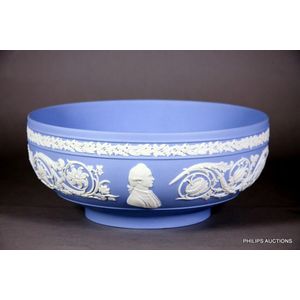Wedgwood Blue Jasper Bowl Commemorating Captain Cook's Landing
You must be a subscriber, and be logged in to view price and dealer details.
Subscribe Now to view actual auction price for this item
When you subscribe, you have the option of setting the currency in which to display prices to $Au, $US, $NZ or Stg.
- Arabesque - The arabesque pattern is an ornamental design that features flowing, curving lines and elaborate geometric shapes. It is inspired by the art and architecture of the Islamic world and was developed at Fontainebleu France in the mid 16th century. Its use was spread through published engravings, and it is characterized by its intricate and highly decorative nature. The arabesque pattern is created using a repetitive motif that is repeated and interwoven to create a cohesive design. It was used as a form of decoration in art, architecture, textiles, pottery, furniture and ceramics and it is often used to add a sense of grandeur and sophistication to a design. The arabesque pattern is admired for its beauty and complexity, and it continues to be used in a wide range of decorative contexts today.
- Circa - A Latin term meaning 'about', often used in the antique trade to give an approximate date for the piece, usually considered to be five years on either side of the circa year. Thus, circa 1900 means the piece was made about 1900, probably between 1895 and 1905. The expression is sometimes abbreviated to c.1900.
- Frieze - An architectural term denoting the flat, shaped or convex horizontal surface of furniture, between the architrave and the cornice, usually found on a cabinet or bookcase, or on desks and tables where it may include drawers, the area between the top and the legs. In ceramics, the term refers to the banding, of usually a repeating pattern, on the rims of plates and vases.
This item has been included into following indexes:
- Cook, Captain James - memorabilia 179
-
Wedgwood (England), item types
- bowls 186
- bowls, Jasperware 52
- commemorative items 30
Visually similar items

A Chinese export polychrome-decorated porcelain basin, late 19th/early 20th century, the exterior decorated in coloured enamels with reserves alternately painted with scenes of figures in interiors and on terraces and with flowers, birds, and butterflies o

A yellow-ground 'famille-rose' bowl seal mark and period of Daoguang with rounded sides rising from a slightly tapering foot to the gently flared rim, densely painted on the exterior with a composite floral scroll of peony, lotus, lilly and hibiscus on ent

A Chinese blue and white bowl, Qing Dynasty early 18th century, decorated with lotus sprays in pencilled style, Chenghua mark. 8 cm high, 17.9 cm diameter, box

A Wedgwood blue jasper round bowl, circa 1910 decorated with various medallions, including Venus bound, Aurora's chariot, the three Graces and Cupid asleep, 20 cm diameter
